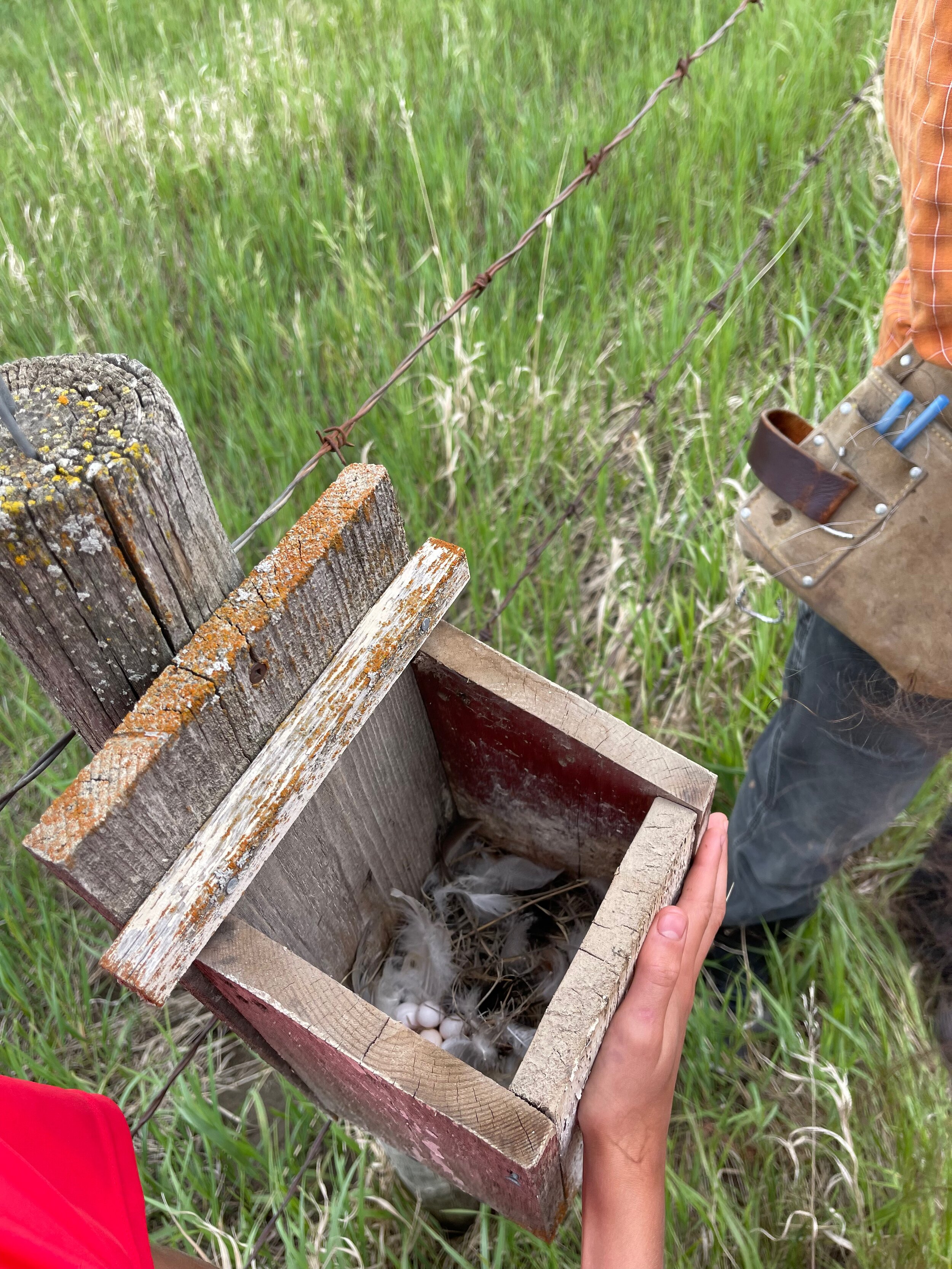Along the Bluebird Trail
On the weekend our family had the greatest joy in accompanying Greg Fenty of the Saskatoon Young Naturalists to check bluebird nest boxes, count eggs and assist Greg as he leg banded a few birds. You may have noticed the bird nest boxes on fence posts, some on the way to Grandora, others towards Pike Lake and still more towards Blackstrap.
The boxes are hung in pairs and spaced out along the grid roads. Bluebirds don’t mind Tree Swallows as neighbours, and vice versa but they prefer a bit space from their own species. While we see farmland segregated by barbed wire nowadays this land was once unbroken prairie and shrubland. Both Bluebirds and Tree Swallows are insectivores so they need to nest where there will be lots of insects. Both bird species are cavity nesters, in the past they would have nested in tree cavities or enlarged old woodpecker holes.
European House Sparrows were introduced in the 1850s to the Americas and within 50 years were found across the continent. House Sparrows outcompete Bluebirds and Tree Swallows for habitat. Both Bluebirds and Tree Swallows migrate to the southern United States every winter to maintain their insect diet. House Sparrows stay here all year round, can raise three clutches of eggs each summer and are omnivores, i.e. they can survive on seeds all winter so they don’t need to migrate. Supplying the nest boxes provides more habitat for the birds to nest and is easier to find and check nests rather than scrambling into copses of trees on farmer’s private property and trying to reach nests.
In 1968 Mary Houston started the Saskatoon portion of the Bluebird Trail with a children’s group which became the Young Naturalists. Bluebird populations plummeted in the 1950s and 1960s with rampant pesticide use, either their food source wasn’t available or it was poisoned. Greg joined her and has been banding Bluebirds and Tree Swallows for over 35 years. Many conservation groups across Canada check Bluebird nest boxes but the Saskatoon Young Naturalists program is special in banding Bluebirds and Tree Swallows. Like many birds, the Bluebirds and Tree Swallows that are born here return to the same nesting spot each year. Greg has tracked this when he captures a bird and can see from its leg band that it’s one he tagged a previous year. Many birds live 2-3 years making a migration of over 4,000 kilometres each fall and spring.
Before we approach the first nest boxes Greg explains that we may find Bluebird, Tree Swallow, House Wren, or House Sparrow nests. Bluebirds are cousins to Robins and have small blue eggs. I was surprised that the eggs weren’t smaller since Bluebirds are smaller than Robins. House Sparrows build grass nests with a roof woven above. Wrens build their nests of twigs. We saw the most Tree Swallow nests, with clutches of between 4-7 eggs. Tree Swallows line their nest with feathers, downy and soft making a warm haven. The eggs seemed to glow, whiter than white and a few almost pink. They looked a bit like the Candy Eggs you see at Easter. We do find a nest box that seems empty but has a paper wasp nest just started and wiggling larvae within. Greg carefully closes the box up and makes a note for future participants on the Bluebird trail.
The kids are excited, first to cover the entry hole and wait impatiently while Greg removes the top. Some nest boxes have eggs and the irate Tree Swallow parents circle closer to drive us away. We learn that if the chicks had hatched the parents would be even more protective. A few times we walk back to our vehicles and try to out wait the parents, hoping they will enter the nest box so we can capture and leg band them. Their sense of survival is strong and they can fly down and check their eggs and leave faster than we can race back to the nest box.
We visit 20 boxes on our first day and find 8 Tree Swallow nests, 1 Bluebird nest and 1 sparrow nest and see a male Bluebird driving home. Only one Tree Swallow is already banded, the others must have nested in trees previously or this is their first year nesting. Kneeling down with his tool belt of pliers and a string of leg bands, Greg deftly bands the female before gently transferring her to the children whom he has already shown the proper hold and had them practice on a small Styrofoam bird. He states emphatically that birds know how to fly, when it is time to release the adults you just open your hand the bird flies away.
We watch the Tree Swallows circle above us, freewheeling aeronauts, a few more insects devoured and back to check on their eggs. Before he passes a banded bird over, Greg gently blows on the birds belly, if it’s bare he notes it’s a female who rubs the feathers off in the weeks of her soft belly warming her eggs. The females spend more time sitting on the eggs than the males do and so this tiny sign of the division of labour is revealed. Greg shares that when he’s seen adult birds returning to their nest they’ll have a whole beakful of insects for their chicks.
Holding a female Tree Swallow in his large hands, we marvel at her iridescent colouring. She’s purple, and indigo – her colour changes in the light, a bit like gasoline in a puddle. When Greg spreads her wing to look for feathers that will tell us her age, the fragility of those feathers is startling. Every person should feel that gaze of wonder upon them at least once in their lifetime.
Learn more about the Young Naturalists and the wonderful, hands on, kid focused activities they do here. There is still time to help with the Bluebirds this spring and summer, for dates you can reach Greg at saskatoonnaturekids@gmail.com
We decided to dye some of our wool roving to make a bluebird nest and eggs. We needed three colours, a foam block and some felting needles. We used food colouring and hot water, and heated the three bowls of colours up individually in the microwave. Then we put together this little nest with three bluebird eggs. Now to make a bluebird!



















